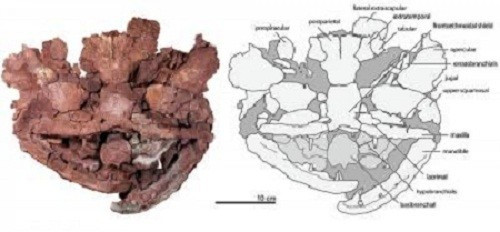Scientists Find New Species of Ancient Toothy Fish in Canadian Arctic

Scientists have discovered a species of ancient predatory fish that lived 375 million years ago in North American waterways during the Devonian Period 400 million years ago.
The fish, named Laccognathus embryi, may have grown about 5 or 6 feet long, had a wide head with small eyes and robust jaws lined with large piercing teeth. The fish, whose closest living relative is the lungfish, had thick, quarter-size scales and a wide mouth--sort of like a modern-day grouper.
I wouldn't want to be wading or swimming in waters where this animal lurked, said Ted Daeschler, co-author of the paper and a vertebrate zoologist at the Academy of Natural Sciences. Clearly, these Late Devonian ecosystems were vicious places, and Laccognathus [meaning pitted jaw] filled the niche of a large, bottom-dwelling, sit-and-wait predator with a powerful bite.
The Devonian Period, spanning from 360 to 415 million years ago, is often described as the Age of Fishes because of the rich variety of aquatic forms that populated the ancient seas, lagoons and streams.
The Devonian was a fish-eats-fish kind of world, Daeschler said. There was a real arms race going. If you [were a smaller fish and] didn't have good armor on your body, you were very vulnerable.
Daeschler said the 375-million-year-old beast was the kind of fish that was waiting to lunge out to grab whatever was in front of it.
The fossil head looks like a big, smiling face looking up at you, added Daeschler, whose research was funded by the National Geographic Society's Committee for Research and Exploration.
The researchers found the fish fossils during several excavations in a siltstone flood deposit on Ellesmere Island in Nunavut, far northern Canada. The name Laccognathus embryi is in honor of a Canadian geologist Ashton Embry, whose Arctic research helped prepare the scientists for their fieldwork.
In 2004, the same group of researchers discovered Tiktaalik roseae in the Arctic site. Tiktaalik roseae lived during the same period as Laccognathus embryi and is considered to be a crucial link between fish and early limbed animals.
The kind of fish - Laccognathus - was previously only known from Eastern Europe. The discovery of Laccognathus embry extends the geographic range of Laccognathus to North America and confirms direct connection of the North American and European landmasses during the Devonian Period.
This study is the culmination of a lot of work in the field, in the fossil lab, and in the office, said lead author Jason Downs, an Academy research associate and a visiting professor at Swarthmore College.
© Copyright IBTimes 2024. All rights reserved.





















